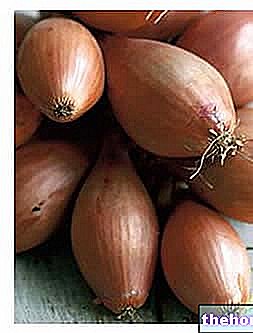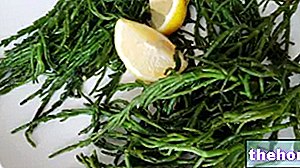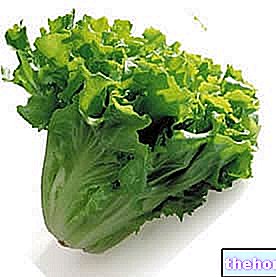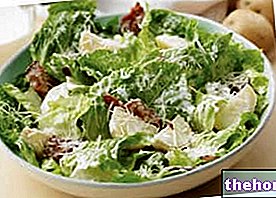Generality
For red cabbage (or red cabbage) we mean a food of vegetable origin, obtained from an edible plant belonging to the Brassicaceae family.
Closely related to savoy cabbage, cauliflower, broccoli and turnip greens (but not only), the red cabbage plant is identified by the binomial nomenclature Brassica oleracea, cultivar capitata f. rubra.
NB. The specification of the cultivar is essential to distinguish the red cabbage from the others mentioned above, instead belonging to the cultivars: Savoy, botrytis, italica And sylvestris.

Red cabbage is also known as purple cabbage or red or blue sauerkraut.
It has dark red, tending to purplish leaves. However, thanks to a pigment belonging to the family of anthocyanins (flavins), the plant changes color according to the pH of the soil.
Red cabbage is widespread in Northern Europe, the Americas and China. It requires well-fertilized soil, with "sufficient moisture for its vegetation. It is a seasonal plant that is sown in spring and harvested in late autumn." It is a cultivar that resists the cold better than the white one and does not need to be converted into sauerkraut to ensure its availability in the winter.
Nutritional Characteristics
Compared to green cabbage, red cabbage has a 10 times higher content of pro vitamins A and twice as much iron.
Red cabbage is a vegetable that falls into the VI and VII food groups, thanks to the considerable contribution of retinol equivalents (pro vit A) and vitamin C (very useful in the winter period, when most vegetables are scarce). These vitamins are two powerful antioxidants and exert a good effect against free radicals by preventing the aging of tissues and some forms of cancer.
To support this antioxidant and anticarcinogenic effect, phenolic pigments (anthocyanins) also contribute, which appear numerous and rather concentrated in red cabbage. Equipped with a positive effect also on metabolism, this time in synergy with dietary fiber (well present), polyphenols help maintain normal blood cholesterol levels.

Nutritional values (per 100 g of edible portion)
Dietary fiber also has a positive effect on the trophism of the intestinal bacterial flora and on the transit of feces, preventing constipation and some forms of colorectal cancer.
NB. Vitamin C tends to be degraded with cooking; beta-carotene (retinol equivalent) is found more in the outer leaves than in the central ones. However, these are usually discarded for hygiene reasons, especially in the diet of the pregnant woman (to reduce the risk of contracting the dreaded toxoplasmosis).
Red cabbage is a low-energy food, with a caloric prevalence of carbohydrates, followed by proteins and finally by very small parts of lipids. Carbohydrates are simple (fructose) and peptides have a low biological value.
As far as mineral salts are concerned, red cabbage should bring a good amount of potassium (not mentioned in the table) and iron (compared to the food category it belongs to).
The average portion of red cabbage is around 100-300g (20-60kcal).
Use in the kitchen
Red cabbage can be eaten raw or cooked.
It is a food that tends to stain hands and clothes a lot. After cooking, it normally turns blue and to preserve its pigment it is necessary to add vinegar or sour fruit (eg lemon) directly during cooking.
Red cabbage is often used as a raw appetizer, for mixed or just cabbage salads. It is a traditional German and cooked side dish that accompanies many dishes, such as Sauerbraten.
At Christmas, it can be seasoned and served in association with the seasonal roast goose.
Curiosity
On acidic soils, red cabbage leaves grow red or pink or magenta, on neutral soils purple, while in alkaline soils they turn blue or yellow or greenish. This explains the fact that the same plant is widespread in different regions but with different colors.
For the same reason, red cabbage juice can be used as a home pH indicator; in practice, this becomes red with the addition of acidic components and green or yellow in a basic solution.
Other Foods - Vegetables Garlic Agretti Asparagus Basil Beets Borage Broccoli Capers Artichokes Carrots Catalonia Brussels sprouts Cauliflower Cabbage and Savoy cabbage Red cabbage Cucumber Chicory Turnip greens Onion Sauerkraut Watercress Edamame Chives Chanterelles Flour Cassava Flowers Pumpkin Flour Edible Flowers Pumpkin Seasonal Fruits and Vegetables Endive Salads and Salads Strengthening Salad Lettuce Aubergines Vegetables Nettle Pak-Choi Parsnip Potatoes American Potato Peppers Pinzimonio Tomatoes Leeks Parsley Radicchio Turnips Red Turnips Radishes Rocket Shallots Endive Celery Celeriac Seeds Sprouted Spinach Truffle Valianamberi or Jerusalem artichoke laxatives Saffron Pumpkin Zucchini Vegetables - Nutritional properties OTHER VEGETABLE ITEMS Categories Food Alcoholics Meat Cereals and derivatives Sweeteners Sweets Offal Fruit Dried fruit Milk and derivatives Legumes Oils and fats Fish and fishery products Cold cuts S pezie Vegetables Health recipes Appetizers Bread, Pizza and Brioche First courses Second courses Vegetables and Salads Sweets and Desserts Ice creams and sorbets Syrups, liqueurs and grappa Basic preparations ---- In the kitchen with leftovers Carnival recipes Christmas recipes Light diet recipes Women's Day, Mum, Dad Recipes Functional Recipes International Recipes Easter Recipes Recipes for Celiacs Recipes for Diabetics Recipes for Holidays Recipes for Valentine's Day Recipes for Vegetarians Protein Recipes Regional Recipes Vegan Recipes



















-nelle-carni-di-maiale.jpg)








